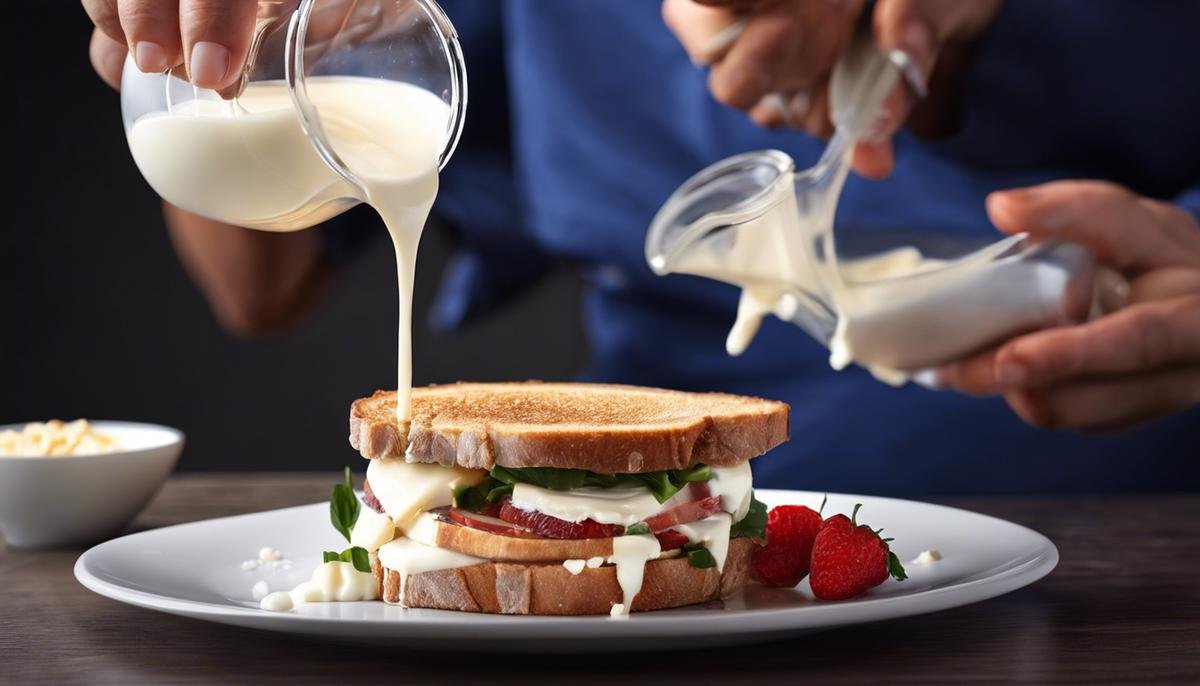
Delving into the dietary choices we make for our loved ones, particularly for those with autism, can be a profound journey of discovery and health. One path that many have explored is a casein-free diet—a regimen that removes a common protein from their plates in the hope of enhancing wellbeing. This essay invites you into the world of casein-free living, uncovering what casein is, where it lurks within our food supply, and the rationale behind its elimination. By examining the latest research and gathering insights from those who have walked this path, we offer an informative guide for anyone contemplating a casein-free lifestyle, particularly for families navigating autism spectrum disorder.
Understanding Casein-Free Diets
Embracing the Casein-Free Family Life: What You Need to Know
Hey there, lovely families!
Navigating the world of dietary needs can be a bit of a rollercoaster, especially when it involves the whole family. Have you been hearing the buzz about going casein-free and wondered what it’s all about? Well, let’s unwrap this topic together and see how it can fit into your family’s lifestyle.
First things first, casein is a protein found in milk and dairy products. It’s what gives milk its white color and contributes to the creamy texture of dairy delights. But for some families, casein doesn’t bring joy. Instead, it’s the culprit behind allergies and digestive woes. That’s where the casein-free diet comes into play.
Going casein-free means bidding adieu to all products containing casein. This includes the obvious, like milk, cheese, and yogurt, but also some less obvious items such as butter, ice cream, and even some brands of margarine. Always keep an eye out for sneaky casein in processed foods, where it can lurk under names like sodium caseinate or calcium caseinate.
Making the switch to a casein-free diet doesn’t have to be daunting. Begin by introducing casein-free alternatives into your family’s routine. Almond milk, coconut yogurt, and vegan cheese are just a few of the many substitutes that can make the transition smooth and, dare say, exciting. There’s a whole world of plant-based products waiting to be explored!
One of the tricks to success is meal planning. Map out your grocery trips with a list of casein-free products and recipes. This keeps things stress-free and ensures everyone at the dinner table is happy and healthy. Don’t hesitate to experiment with new recipes—there are plenty of online resources and cookbooks dedicated to casein-free living.
But what about the kids, you ask? Well, you’d be surprised how adaptive and open they can be when it comes to dietary changes, especially when they feel involved in the process. Make it fun by having them pick out new snacks or help with cooking a casein-free meal; it’s a great opportunity for bonding and education.
Let’s not forget that switching to a casein-free lifestyle is also a chance to refocus your family’s eating habits towards whole and unprocessed foods. Think fresh fruits, vegetables, legumes, and grains – nature’s bounty is both delicious and naturally casein-free!
And here comes the silver lining: going casein-free can be a boon for health. It might help alleviate digestive issues, improve skin conditions, and even contribute to a better night’s sleep for those sensitive to casein.
Of course, before diving into any dietary change, it’s important to consult with a healthcare provider, especially if you have concerns about allergies or nutritional deficiencies. They can provide personalized advice and ensure your family’s nutritional needs are met.
Now, it’s not just about removing casein from your diet; it’s about creating new habits and exploring new favorites that work for everyone in the family. Going casein-free is a journey of discovery, with each step paving the way to a tailored and health-conscious family lifestyle. Embrace it with open arms and a sprinkle of creativity, and you’ll find that this change can be as satisfying as it is beneficial.
So, here’s to happy tummies and vibrant health! Cheers to the families embarking on the casein-free path; let’s make it a scrumptious adventure together!

The Connection Between Casein-Free Diets and Autism
Switching gears to a topic that has piqued the curiosity of many parents within the autism community, the question du jour is: Can a casein-free diet really impact autism symptoms?
As the parent-hive buzzes with anecdotes and testimonials on dietary interventions, it’s crucial to dive into the connection between casein-free diets and autism. The theory hinges on the fact that some children with autism may have a heightened sensitivity to certain proteins, including casein, that could potentially affect autistic behaviors.
Research in this area is ongoing and quite promising. Some studies suggest that by removing casein, there could be a decrease in behavior issues, better social engagement, and even improved speech in some children with autism. However, it is important to note that these results are not universal and can vary from child to child.
An often-overlooked aspect of implementing a casein-free diet is the importance of ensuring nutritional balance. When dairy is out of the picture, it’s crucial to find alternative sources of calcium and vitamin D, which are vital for bone health. Enriched non-dairy milks, leafy greens, and fortified cereals can fill this gap quite nicely.
Another piece of the puzzle is the role of the gut-brain connection. Some experts believe that by eliminating casein, there may be improvements in gut health that could then positively impact neurological function. This is particularly interesting since digestive issues are common in the autism community.
Embracing a casein-free diet is no mere fad; it’s a full-on strategy that demands commitment and a willingness to experiment. Parents often notice that while their child’s response to the diet might not be dramatic, there are often subtle shifts that hint at the positive role of this dietary change.
In the end, while the jury might still be out on the extent of its efficacy, many families find that a casein-free diet offers a piece of the puzzle in supporting their child’s well-being. It’s a step that, when carefully considered and monitored, can be a wholesome part of nurturing a child’s potential. As with any change, hope is served best with a dollop of open-mindedness and a sprinkle of patience.

Photo by darkandflawed on Unsplash
Implementing a Casein-Free Diet
Transitioning to a casein-free lifestyle can seem intimidating at first, especially for families. It’s like learning a new language or starting at a new school, it takes a little getting used to, but with a few smart strategies up your sleeve, this lifestyle change can be woven into the fabric of daily life with grace and ease.
Discovering new favorite recipes is a great place to start. While favorite dishes might originally include casein-rich ingredients, there are countless ways to modify these recipes to be casein-free without losing their appeal. Enlisting the help of online communities and casein-free cookbooks can introduce families to a world of flavorful, satisfying, and creative meals that just might become new staples at the dinner table.
When dining out or visiting friends and family, communication is key. Don’t be shy about discussing dietary needs with hosts or restaurant staff; many are more than willing to accommodate or suggest casein-free options. Providing a heads-up not only ensures a smooth dining experience but also raises awareness and understanding among others.
In birthday parties and social gatherings, bring along a casein-free dish to share. This not only guarantees there’s something on the menu everyone can enjoy, it’s also a lovely way to introduce others to the possibilities of delightful casein-free cuisine.
For those with children, turning the casein-free transition into a family project fosters unity and teaches valuable lessons about nutrition and health. Families can explore farmer’s markets together, pick out casein-free products, and even turn meal prep into a playful event. Through shared experience, children learn to make wise food choices outside the home as well.
Label-reading should become second nature. Since casein can be hidden under different names, understanding labels is crucial. Make it a game to find casein-free products by playing ‘detective’ in the grocery aisles—little ones often have a blast with this game while learning to be savvy consumers.
Lastly, remember the power of patience. Any significant dietary shift doesn’t happen overnight. Gradual changes are usually more sustainable than cold-turkey approaches. Celebrate small victories, whether it’s finding the perfect casein-free milk alternative or nailing that dairy-free homemade pizza that gets rave reviews from the whole family.
There you have it, folks! With a sprinkle of creativity, a dash of adventure, and a big helping of patience, weaving a casein-free lifestyle into the family tapestry is not just doable, it can be a rewarding way to forge stronger family bonds and healthier habits. Here’s to happy, healthy, casein-free living!

Casein-Free Recipes and Meal Planning
Delightful Casein-Free Meal Ideas for Little Tummies
Preparing casein-free meals doesn’t have to feel like finding a needle in a haystack. In fact, this dietary path can be a colorful adventure into the universe of fresh flavors and creative combos, with health and happiness waiting to be plated at every meal! Let’s dive straight into some mouth-watering meal ideas that will keep the kiddos not just happy, but over the moon and thriving.
Breakfast is often referred to as the most important meal of the day, and we wholeheartedly agree. Kick off the morning with a satisfying casein-free smoothie bowl. Imagine a thick blend of bananas, berries, and a splash of almond milk, topped with crunchy granola, sliced fruit, and a dollop of sunflower seed butter. It’s a morning treat that provides sustainable energy and a hurdle-free start to the day.
Lunch boxes can be a hotspot for hidden casein, so let’s ensure they are a safe haven of nutritious eats. For an all-star midday meal, envision vibrant veggie wraps: a rainbow of peppers, cucumbers, and carrots snugly enveloped in a casein-free tortilla with hummus as the glue. Add a cup of vitamin-packed fruit salad, and you have a lunch that screams fun and fuels play throughout the day.
When the sun wanes and dinner calls, nothing says home like a warm plate of food. How about a heaping serving of casein-free spaghetti aglio e olio – a simple yet timeless Italian dish featuring garlic, olive oil, and a sprinkle of chili flakes atop perfectly-cooked pasta. Pair this with steamed broccoli or roasted Brussels sprouts, and it’s a well-rounded feast that’s simple, yet sophisticated for refined little palates.
Let’s not forget that children often dream in snacks and treats. Ditching casein doesn’t mean ditching decadence. Delight them with baked cinnamon apple chips or homemade oatmeal raisin cookies made with dairy-free substitutes. These are the kind of snacks that disappear quickly but leave a legacy of smiles and satisfaction.
Remember, a casein-free diet is not a bowl of bland or a plate of predictability. Each meal is a chance to celebrate fresh picks and flavors from the garden of life. With the foundation of these ideas, turn mealtime into a joyful exploration that supports wellness and dietary needs without skipping a beat on delight.

Monitoring Changes and Evaluating Progress
Tracking the Effectiveness of a Casein-Free Diet in Children with Autism
Embarking on a casein-free journey, especially for those loving families supporting a child with autism, brings a bouquet of challenges and learning curves. Marrying sincerity with scientific insight can lead to unraveling new layers of your child’s well-being.
When considering the evaluation of a casein-free diet’s influence on autism, consistency and a keen eye for detail are paramount. The groundwork lies in establishing a baseline before embarking on this dietary path. Jot down information about your child’s behavior, communication abilities, sleep patterns, and any digestive issues. This snapshot becomes invaluable as you monitor progress.
As weeks unfold into months, maintain a detailed food diary along with observations of any behavioral changes. Note any increments in eye contact, social interaction, language skills, or a decrease in behaviors like self-stimulation or irritability. Remember to take into account other variables that could influence behavior, such as changes in routine or life events.
Close collaboration with professionals like dietitians and your child’s healthcare team ensures that the casein-free diet is nutritionally complete and that any improvements or concerns are properly evaluated. Regular check-ins with these professionals help objectively assess the effectiveness of the diet.
Some families opt for structured assessments using standardized tools that therapists or doctors provide. These instruments can help chart progress in communication, social skills, and behavioral aspects over time.
Moreover, observing changes in physical health can also indicate the diet’s impact. For instance, an improved gut function, fewer instances of constipation, or a more robust immune response are tangible health benefits that may surface.
Embrace the use of technology to support this venture. Mobile apps designed for tracking dietary intake and symptoms related to autism can offer a convenient and systematic approach to monitoring your child’s response to the casein-free diet.
Lastly, the community aspect cannot be overstressed. Engage with forums, online groups, or local support networks where experiences and observations are exchanged. Real-life stories and shared journeys can provide insights that are both enlightening and encouraging.
Bottom line, the true measure of a casein-free diet’s success is the affirmative change in the quality of life for the child and family. While scientific research presses on, the lived experiences and journeys of diligent parents serve as a compass guiding towards a holistic understanding of the relationship between casein-free diets and autism. The beautiful tapestry of every family’s story contributes to what we know and what we hope to achieve – happier, healthier lives for our kids.

Embracing a casein-free diet is much like embarking on a culinary adventure—one that demands creativity, commitment, and an open mind. As we’ve journeyed through the intricacies of such a dietary choice, from the scientific discussions to the practical implementation and beyond, it’s clear that the real measure of success lies in the health and happiness of those who partake in it. While the path to understanding the full impact of casein-free diets on autism remains a work in progress, the stories and steps outlined offer a starting point for families seeking to enrich their lives through mindful nutrition. Ultimately, it is the observant and nurturing environment, where food meets compassion, that nurtures progress and fosters hope for countless families.




